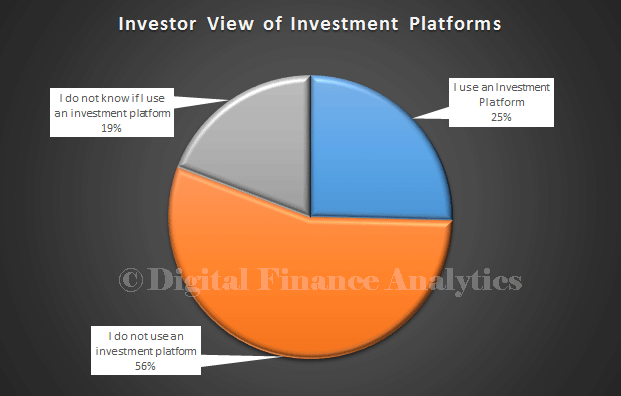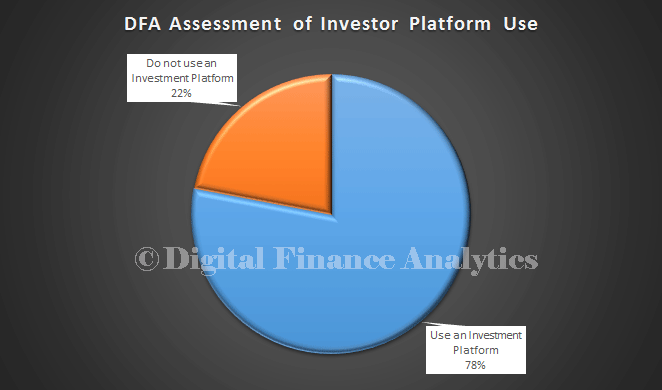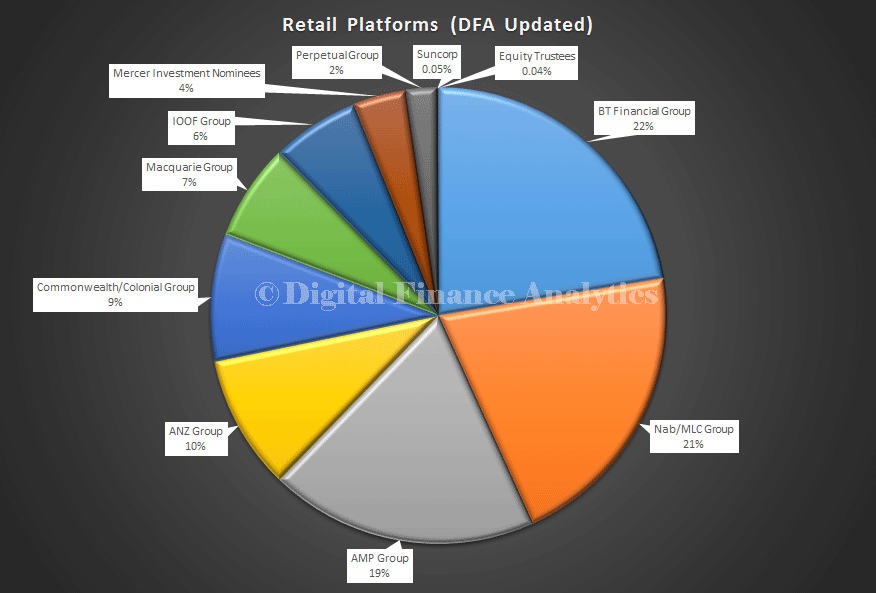
By Martin North. Cross Posted from Digital Finance Analytics Blog
In previous posts we looked at aspects of superannuation in Australia, from the perspective of investment fund performance, fees, consumer attitudes to super and self-managed super. Today we look at the role of investment platforms, an element in the superannuation value chain which is often overlooked by investors, but recommended by financial advisors as part of a wealth management strategy. An investment platform is an administrative system for investments, offering a range of services and consolidated reporting. It might be used by a financial planner on behalf of their client, or by the investor personally, or both.
In our household survey we asked about investment platforms. Most households thought they were not using a platform, or did not know:
 Which was strange because when we asked about the nature of investments, and who they were investing through, it became clear that many were in fact investing via a platform recommended by their financial planner:
Which was strange because when we asked about the nature of investments, and who they were investing through, it became clear that many were in fact investing via a platform recommended by their financial planner:
 Actually, over 75% of the platforms are owned and managed by the big banks. Here is data from 2009. As more recent data is hard to track down from public sources, we tweaked the numbers to take account of AMP’s acquisition of AXA, and nab’s of Aviva. Perpetual outsourced to Macquarie, but we show this separately. Market shares have probably changed since then.
Actually, over 75% of the platforms are owned and managed by the big banks. Here is data from 2009. As more recent data is hard to track down from public sources, we tweaked the numbers to take account of AMP’s acquisition of AXA, and nab’s of Aviva. Perpetual outsourced to Macquarie, but we show this separately. Market shares have probably changed since then.
 The MLC/nab platform would be used by financial advisors from for example, Apogee, Garvan, Godfrey Pembroke or nab Financial Planning. Masterkey, Custom, Plum and Navigator are all under the MLC/nab umbrella. The relationship between the platform and advisor is not necessarily transparent. The problem is that advisors may be influenced by the choice of investments on their platform, so the advice may be less independent than it appears.
The MLC/nab platform would be used by financial advisors from for example, Apogee, Garvan, Godfrey Pembroke or nab Financial Planning. Masterkey, Custom, Plum and Navigator are all under the MLC/nab umbrella. The relationship between the platform and advisor is not necessarily transparent. The problem is that advisors may be influenced by the choice of investments on their platform, so the advice may be less independent than it appears.
Investment platforms might be a master trust, or a wrap. There are some legal differences between the structures, but from a consumer perspective, they function in similar ways. 2020DirectInvest compare and contrast wraps and master trusts:
“One of the main ways that a wrap platform will differ from a master trust relates to transferring assets held in the account. With master trusts, the underlying funds (investment options) are specific to that master trust, and if you owned units in a fund through master trust A, you would not be able to transfer these to master trust B. Instead you would have to sell the underlying investments in one product and repurchase them in the other product resulting in a capital gains event, as well as transaction costs.
Wrap accounts revolve around a central cash account, which pays interest and serves as a transitional account, funding buy transactions for shares and managed funds, and receiving the proceeds when shares and managed funds are sold. Depending on the wrap platform, cash accounts can be online bank accounts, cash management trusts or a full featured bank account with a cheque book facility. Investors are usually required to maintain a minimum cash account balance to pay their administration fees (typically $1,000-$5,000), and buy transactions can only be executed if the cash is available in the cash account.
Investors are able to invest in a broad range of managed investments and shares to diversify your investment portfolio. Once an investor has opened a wrap account, it is only necessary to meet the minimum per holding investment amount of the wrap platform – typically $1,000 – irrespective of the high minimum investment amount the investment fund requires from direct investors.”
Wraps may give access to wholesale investments normally not accessible to retail investors, and there are tax benefits relating to fees. However, master trusts or wrap accounts are often used by financial planners because they make it easier for the planner to plans, arrange and monitor their clients’ investments. In fact, sometimes it appears the convenience factor benefits the planner more than the client.
Fees are a potential problem. If an investor made a direct retail investment into a unit trust, they might pay commission in the order of 1.4%. Investing via a wrap at wholesale rates will be lower, say 0.9%. However, the investor now also needs to pay for the platform. These fees vary, somewhere between 0.3% and 1%. So its possible a wrapped investment will be higher. There is another issue also. Some platforms deduct advisor fees automatically, even if an advisor was not involved, so end users trading though their platform still may pay. These fees, which were once regarded as commissions, but now are “asset-based” fees may lift the total fee take by another 1%. In all, fees may dilute performance, as we illustrated in our previous piece.
The industry is also evolving fast. The first platform in Australia appeared in 1987, when the then Sealcorp launched its first master trust. Significant investments have been made since then. For example, the AXA platform was valued at around $60m when AMP acquired the business. At the time nab was blocked from acquiring by the ACCC because of industry concentration concerns. At least $100m was spend in 2013 on platform development and enhancement across the industry. The industry is seeking to build greater flexibility into the platforms, offering choice of function (and fees) and also a transaction based pricing alternative.
Changes to the financial advice model (some being reworked by the new Abbott government), which includes a no cost/low cost default fund, documentation requirements and other changes are also in train.
The rise of online services, mobile devices and self-service is creating challenges for the traditional players. Some advisors are seeking alternative investment strategies, avoiding the higher cost wraps, by focusing on exchange traded funds, for example. The arrival of a listed operating model for managed funds under the Australian Securities Exchange’s (ASX’s) Aqua II project may have an important impact on the market. This service will allow fund managers to put their products up and have them listed as ASX products.
The rise of self-managed super funds are creating an opportunity for some platforms to launch SMSF variants. AMP for example has developed a SMSF solution on its platform, with reduced function and lower fees to target this sector.
Industry experts believe the pressure on fees will continue to rise, so it will be interesting to see how they morph. What is clear however, is that investors and potential investors need to be know more about the role and function of the investment platforms. Today there are more than 50 “platfoms”, but actually powered by a small number of the large banks and other players. The industry is more concentrated than it may appear.

